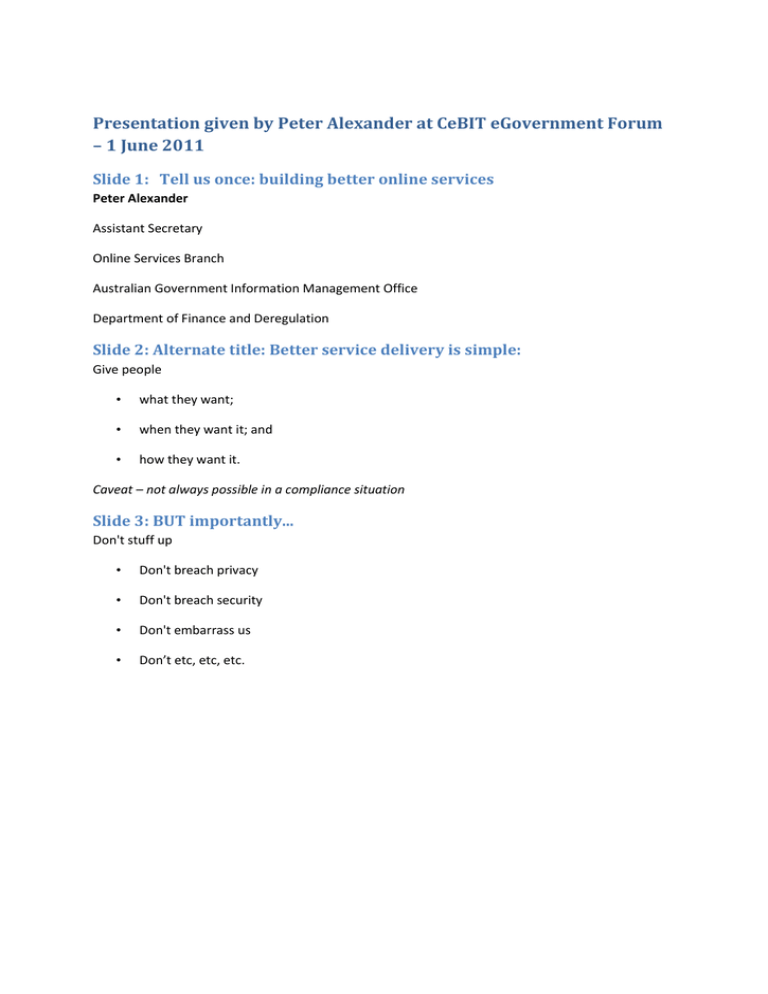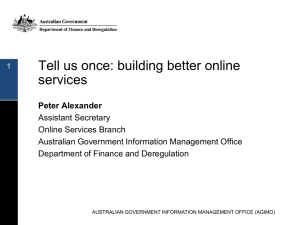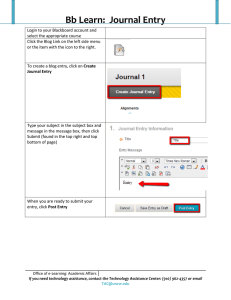Presentation given by Peter Alexander at CeBIT eGovernment Forum Slide 1:
advertisement

Presentation given by Peter Alexander at CeBIT eGovernment Forum – 1 June 2011 Slide 1: Tell us once: building better online services Peter Alexander Assistant Secretary Online Services Branch Australian Government Information Management Office Department of Finance and Deregulation Slide 2: Alternate title: Better service delivery is simple: Give people • what they want; • when they want it; and • how they want it. Caveat – not always possible in a compliance situation Slide 3: BUT importantly... Don't stuff up • Don't breach privacy • Don't breach security • Don't embarrass us • Don’t etc, etc, etc. Slide 4: The internet is the preferred channel for government services Slide 5: 45% of Australians prefer contacting government via internet over other channels Pie chart - 45 per cent internet, 32 per cent phone, 17 per in person, 2 per cent mail. Source: Interacting with Government: Australians’ use and satisfaction with e-government services 2009 Slide 5 Talking points • AGIMO has run e-Government use and satisfaction surveys for several years – the most recent in 2009, with a new one due in 2011. • The 2009 survey showed that 45% of the survey respondents prefer the internet to access e-government services, compared to a 32% preference for phone, 17% for in-person contact, and 2% mail. Slide 6: This preference has consistently grown over time Graph showing preferences for different contact channels from 2004 to 2009. Internet is the only channel to have grown consistently. Source: Interacting with Government: Australians’ use and satisfaction with e-government services 2009. Slide 6 Talking points Internet is the only contact channel to have grown consistently in popularity over time – preferences for phone, in person and mail contact are either static or falling. Slide 7: The reason: convenience Pie chart: 82 per cent convenience, 26 per cent features, 9 per cent availability. Source: Interacting with Government: Australians’ use and satisfaction with e-government services 2009 Slide 8: Change of Name and Address Survey Change of Name and Address Survey. If you've ever tried to update your name or address details with government, we want to know how it went. Take a few minutes and help us create better government services by completing the Change of Name and Address Survey. Slide 9: Online services: making things easier for the public and improving public sector productivity Slide 9 Talking points • Adding to the convenience factor of online services for the public, there is also a potential for productivity improvements for government: gaining efficiencies through a coordinated approach to online service delivery. Slide 10: Draft ICT Strategic Vision This figure show how the three strategic priorities and six strategic actions of the vision align to support the objective of increased public sector productivity. 1. The strategic actions aligned to the strategic priority “Deliver better services” are “Building capability” and “Enabling better services”. 2. The strategic actions aligned to the strategic priority “Engage openly” are “Collaborating effectively” and “Creating knowledge”. The strategic actions aligned to the strategic priority “Improve Government operations” are “Investing optimally” and “Encouraging innovation”. Slide 10 Talking points • This was one of the key “strategic priorities” of the draft ICT Strategic Vision released on the AGIMO Blog in April 2011, which is intended to shape the direction for the Government’s use of ICT for the next five years. • The Vision discusses the need to provide people and businesses with high quality online services on par with those delivered by the private sector. • The Vision emphasises seamless online services between agencies and different levels of government, and the efficiencies in taking a coordinated approach to this. Slide 11: 1. Good experience Image of person and government websites - caption reading "Find government information and services across the online space". Slide 11 Talking points • Individuals can locate government information and services relevant to them within the online channel. • They have to know the agency that provides the service and then search for it. Slide 12: 2. Better experience Image of a person, a screenshot of australia.gov.au and images of buildings marked Agency A, B and C and connected to the screenshot by two way arrows. Surrounding text reads: Find all information services for government in one place. My intray: one place for all notifications about government including new services and my interactions. My services: deal with government services relevant to me once and tell one, some or all government agencies. Slide 12 Talking points • Government information and services that are relevant to an individual are all in one place. • A central point provides the individual with a personalised view of government based on their circumstances, providing: • One place for all notifications about government including new services and my interactions; • The ability to deal with government services that are relevant to them once and tell one, some or all government agencies. Slide 13: 3. Best experience Image of person, doctor and ID card, with arrows leading to buildings labelled Agency A, B and C. Captions read "When you update your details with your doctor, you can also tell government", and "Find information and services for government anywhere". Slide 13 Talking points • The best experience for an individual could involve them communicating with government via natural pathways • For example, once an individual has visited their doctor, they would be asked whether they want any relevant agencies to be notified of their change in circumstance. Slide 14: Innovative approaches will get us there So how does government innovate? Slide 15: Gov 2.0 Slide 15 Talking points Shows us the way. Slide 16: Service design: engage with people about what services they need Screenshot of Speech Bubble website. Slide 16 Talking points • As with any online engagement: choose your channel: • • Going where the people are? Twitter, Facebook • Setting up a blog, forum etc – Finance’s govspace service makes this fast and costeffective • Building Web 2.0 interactivity into your existing platforms The example shown here: the Department of Human Services’ Speech Bubble blog, which sought feedback about DHS’s proposed service commitments. The blog attracted over 200 comments. Interestingly, these comments came from DHS customers, community organisations and staff – the blog allowed a conversation to form between all of these groups about how DHS should go about delivering services. Slide 17: Service delivery: new channels for support Screenshot of conversation from the Department of Immigration and Citizenship Facebook page. Slide 17 Talking points • Social media is both interesting and challenging as a customer support channel. • Agencies need to be authentic when using social media, but ready to move customers to other channels if needed, especially for privacy reasons. • Eg. the example shown here from the Department of Immigration and Citizenship’s Facebook page, where the customer is directed to make phone or in person contact instead. • An advantage of social media is that from a customer support point of it can essentially function as an FAQ housed on the networks your customers already use in their day to day lives – eg by answering more than one person’s question at the same time on Facebook or Twitter. Slide 18: Service improvement: increased use of online feedback systems Screenshot of "Most Liked Posts" widget on the AGIMO Blog. Slide 18 Talking points • Not necessarily a social media tool, but online ratings are another area of potential improvement for government service delivery. • Existing examples include the 60 second survey on australia.gov.au and (although not quite a service delivery example) the thumbs up/thumbs down rating feature on the AGIMO Blog pictured above. With the blog, we have found this also has a self-regulating function: extremely negative comments tend to be voted down by our visitors. (And we use IP addresses to block multiple votes, so it’s not just Finance staff doing all the voting.) • We should also think of commercial examples such as Amazon, eBay and the Facebook “like” button: not only do they provide feedback to the service provider, but they could potentially help users learn from one another’s experiences – the same principle as Amazon book reviews, applied to government services. Slide 19: Service innovation: open data and Government-powered services Data.gov.au logo Slide 19 Talking points • ...as opposed to government-run services. This is a bit different to what this presentation has been about so far: the goal is to encourage the reuse of government data by the private sector, community organisations and the public to unlock the potential economic and social value of that data. • The point of this is to allow others to create value where Government can’t or won’t by finding new applications for existing data. However, this certainly doesn’t mean that government can outsource all of its own service delivery functions – and of course privacy and security are key considerations in deciding what data government releases. • The Office of the Australian Information Commissioner recently released 10 “Principles on Open Public Sector Information” that call for agencies to adopt open access to government information as their default position unless there is a legal reason not to release it. This builds on past policy decisions such as the Government’s response to the Gov 2 Taskforce and the Declaration of Open Government. • Data.gov.au was launched in March 2011 – the site currently hosts over 250 websites from both Australian Government and state governments, and links to thousands more datasets hosted on other government data catalogues. • The private sector can potentially use government data from data.gov.au and other data catalogues to build new services – eg. integrating the Department of Health and Ageing’s Toilet Map data available on data.gov.au into Google Maps. So as well as the original toiletmap.gov.au website, the data can provide value to the public through the services they use in their day to day lives. Slide 20: Public Services innovation in service delivery comes from Our customers, clients, users. Our suppliers, service providers. Academics, researchers, other governments (jurisdictions) Our leaders. ..... Slide 21: .... and importantly (and often over looked!) ... our staff. • The APS is full of bright and enthusiastic people with great ideas. • We need an environment to enable them to contribute. • To me innovation is engaging with risk. Slide 21 Talking points To get to where we want to be we need to take some chances and be prepared to fail – in an environment that can tolerate failure. Slide 22: Good news: we are seeing pilots, trials and new approaches Early days – here are some pioneers: • Immigration Visa • DHS Connected Authentication • DHS Mobile Offices • Use of Twitter and Facebook – Centrelink and Immigration Slide 23: Thanks



